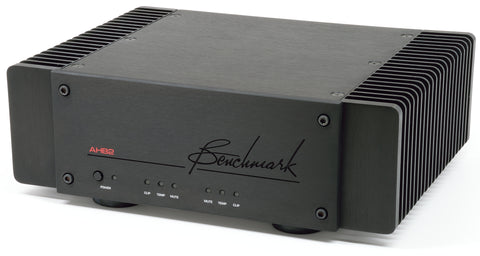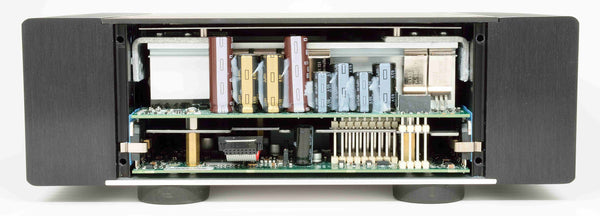Buy one component and save 10% on up to 2 cables. Buy 2 components and get 4 free cables. Free shipping on USA orders over $700.
Buy one component and save 10% on up to 2 cables. Buy 2 components and get 4 free cables. Free shipping on USA orders over $700.
Audio Myth - "Switching Power Supplies are Noisy"
by John Siau May 03, 2016

This Myth Goes Something Like This:
"Switching supplies are noisy."
"Linear power supplies are best for audio."
We disagree!
About 5 years ago, Benchmark stopped putting linear power supplies into our new products, and we replaced them with switching power supplies. We did this because linear supplies are too noisy. Yes, you read that correctly, linear supplies are noisy! A well-designed switching power supply can be much quieter than a linear supply.
Linear Power Supplies Cause Hum
The noise problem is due to the fact that linear power supplies have large transformers and other magnetic components that operate at the AC line frequency (50 Hz to 60 Hz). These line frequencies are audible, and we are all too familiar with the hum and buzz that audio products can produce. It is no secret that this noise is caused by the power supply, but few people understand why it can be so hard to eliminate. Most people think that hum is caused by conducted interference (AC ripple on the power supply rails), but this is rarely the case. Most AC hum is caused by magnetic interference, and this can be very hard to eliminate.
Hum is Usually Caused by Magnetic Interference
Transformers are magnetic devices. Power is magnetically transmitted between a transformer's input and output windings. In a linear supply, power is transmitted from the AC line side of a transformer to the low-voltage secondary side using an AC line-frequency magnetic field. Unfortunately, transformers are never perfect, and some energy always escapes through stray magnetic fields. These stray fields can interfere with virtually every electrical conductor in an audio product. Magnetic shielding is expensive and it has limited effectiveness when sensitive circuits are located in close proximity to a strong field.
Power Amplifiers are the Worst Offenders
The power supplies in high power devices, such as audio power amplifiers, can emit very strong magnetic fields. These strong fields tend to limit the noise performance (SNR) of power amplifiers. These magnetic fields can also cause interference with audio products that happen to be too near the amplifier. Audio cables that enter, exit, or pass near the amplifier may also pick up unwanted hum and buzz. For this reason, it is usually very important to keep the power amplifier well separated from cables and other components in the audio system.
Breaking All the Rules!
Benchmark's new AHB2 power amplifier breaks the rules. It can even be located adjacent to sensitive audio components without causing interference! The AHB2 is a high-power device, but it emits almost no magnetic interference. What makes it different?
The secret inside the AHB2 is the switching power supply. This power supply has several high-power transformers, but they are very small, and their stray magnetic fields are correspondingly small. The reason for this is that the magnetics operate at 200 kHz to 500 kHz. For a given power rating, transformer size decreases as the operating frequency increases. High-frequency transformers have smaller cores and fewer turns of wire. As the physical size decreases, there is a corresponding reduction in stray magnetic field strength.
Size Matters
When transformers are physically small, there are more options for magnetic shielding. For example, the small transformers used in the AHB2 are completely encased in a ferrite material which helps to contain stray magnetics. These techniques are so effective that the AHB2 achieves a SNR of 130 to 135 dB. No power amplifier is quieter than the AHB2. Even more amazing is the fact that the switching power supply board is less than an inch above the amplifier board. This product proves that switching power supplies can be very quiet! The AHB2 could not achieve this level of performance with a linear supply unless the supply were housed in a completely separate box a couple of feet away.
Out-Of-Band Noise
One major advantage of switching supplies is that the operating frequency is above the range of human hearing. If interference occurs, it will not cause audible interference. This interference can even be removed with a filter without infringing on the audio band. But, the power supply in the AHB2 is so quiet that we do not need to filter the audio output. The AHB2 delivers a 200 kHz bandwidth without evidence of any significant switching noise, to a measurement limit of 500 kHz.
Linear Amplification with Switching Supplies
Please note that the AHB2 is not a class-D switching amplifier. The AHB2 is a linear class-AB amplifier. It is only the power supplies that operate in a switched mode. The power supplies simply provide steady and constant regulated DC voltages for the linear audio amplifier.
Efficiency
Another major advantage to switching power supplies is that they can be very efficient. The power supply in the AHB2 achieves an efficiency of over 90%. This means that very little power is lost to heat.
In linear power supplies, massive amounts of power can be lost in voltage regulator circuits. In contrast, switching supplies can produce steady, regulated, DC outputs without consuming extra power.
The Advantages of Regulation
Most traditional power amplifiers have unregulated linear power supplies. Regulation is omitted in order to save power and reduce heat. The negative consequence of this is that the power rails sag with every musical peak. In traditional designs, large banks of capacitors are connected to the voltage rails in order to reduce this voltage sag to manageable levels. Nevertheless it is common to see a significant increase in distortion (THD) when these traditional amplifiers are heavily loaded.
In contrast, the AHB2 has a tightly regulated power supply. This means that the amplifier board in the AHB2 sees constant DC voltages that do not sag when the amplifier is cranking out the watts. The AHB2 does not need, or have, massive banks of capacitors because the power supply responds to the dynamic requirements of the music. This helps prevent any rise in distortion when driving heavy loads, which is one of the reasons why the 8 Ohm, 4 Ohm and 2 Ohm THD numbers for the AHB2 are nearly identical.
Switching Supplies Must Be Optimized for Audio Applications
This discussion would not be complete without pointing out that many switching supplies are noisy. Older designs and low-cost designs tend to use lower switching frequencies that fall within audible frequencies. Many small cellphone and computer chargers fall into this category. These devices can cause interference when placed in close proximity to an audio component or cable.
The switching supplies used in Benchmark products are specifically optimized for audio applications. These switching supplies are much quieter than traditional linear supplies of similar size.
Switching Supply in the AHB2 Power Amplifier
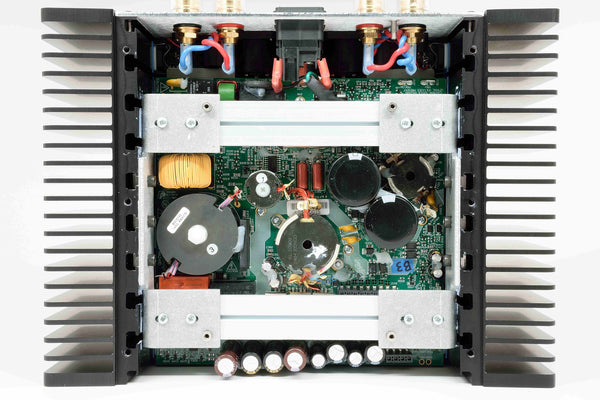
The AHB2 is a linear power amplifier with switch-mode power supplies. To the best of our knowledge, it has the highest SNR of any audio power amplifier. The A-weighted SNR is 132 dB in stereo mode and 135 dB in mono mode. This is 15 to 30 dB better than most of the best power amplifiers. This low-noise performance would not have been possible with a linear power supply. A linear power supply would have created strong line-frequency magnetic fields that would have created low-level line-related hum and buzz. This magnetically-induced line-related interference limits the noise performance of most power amplifiers. Please note that magnetic interference is radiated not conducted. This means that is cannot be removed with filter capacitors. Adding filters to a linear supply will not remove the hum and buzz from a power amplifier.
In the AHB2, the magnetic components (transformers and coils) are fully enclosed in ferrite pot cores. These are the grey cylindrical objects (with wires) shown in the photo above. These high-power magnetic devices are very small because of the high operating frequency. The magnetic field strength is correspondingly small and is well above audio frequencies. The small size also makes it possible to build the magnetic devices inside of ferrite pot cores. These ferrite cores fully encapsulate the coils and greatly reduce stray magnetic fields.
The AHB2 uses a resonant switching design and this greatly reduces the switching noise. The switching transistors are mounted to aluminum bars that transmit the heat to the outer heat sinks.
The power supply is the top board in the AHB2 chassis (shown above). The switching power supply is mounted only 1 inch above the analog amplifier board. A magnetic shielding plate can be seen in the space between the two boards. This plate is quite effective at shielding the low-level high-frequency magnetic fields produced by the switching power supply, but would have little value if the power supply operated at AC line frequencies.
One additional advantage of using a switching supply in a power amplifier is that voltage regulation does not increase the power dissipation of the amplifier. The AHB2 has regulated power supplies (a very unusual feature in a power amplifier). The regulation helps to reduce THD. To the best of our knowledge, no power amplifer has lower THD than the AHB2. Again this is largely due to the use of a switching supply.
The small row of capacitors on the front of the power supply board form the bulk of the capacitance on the power supply outputs. This is far less capacitance than would be needed with an unregulated supply. The switch-mode power supply in the AHB2 has a regulation loop that can respond at audio frequencies. This allows the regulation to respond to musical peaks in real time. Peak currents are drawn from the AC line on demand rather than from stored energy in a bank of capacitors.
Measuring the Magnetic Emissions of the AHB2
The following two photos show how the magnetic emissions of the AHB2 were measured. These measurements verified that the emissions are extremely low. Any audio device may be placed directly above or below the AHB2 in an equipment rack without risk of magnetic interference.
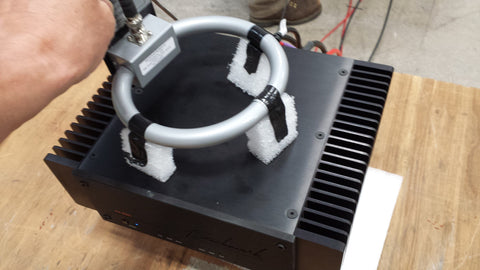
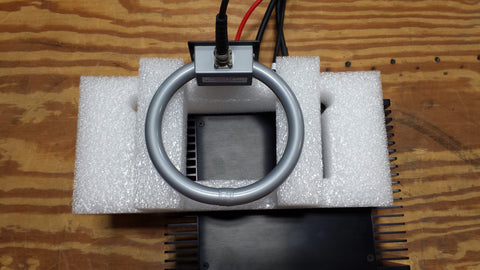
Video Demonstration - Seeing is Believing!
Two months ago, we released a video demonstrating the magnetic immunity of star-quad microphone cables. We exposed the cables to the stray magnetic fields produced by a variety of power supplies, including some rather noisy low-cost switching supplies. We also exposed the cables to the fields produced by a DAC1 and a DAC2. The DAC1 produced magnetic interference, but the DAC2 did not. The difference? The DAC2 has a switching power supply that is optimized for audio application while the DAC1 has a traditional linear power supply. The video shows that the switching power supply in the DAC2 is much quieter than the linear power supply in the DAC1. The comparison is not even close! Sometimes seeing is believing!
Watch a short clip from this video and help put an end to another audio myth!
This application note was edited June 16, 2017 to add photos and descriptions of the switching power supply in the AHB2 power amplifier. - JS
Also in Audio Application Notes

How Loud is the Distortion from Your Power Amplifier?
by John Siau August 08, 2025
Would you put a Washing Machine in your Listening Room?
If the answer is no, you may be surprised to discover that the distortion produced by your power amplifier may be louder than the noise produced by a major appliance.
Don't believe me? Take a look at Stereophile's test reports:
We selected 7 power amplifiers from Stereophile's top list of recommended amplifiers.
We took Stereophile's "THD+N vs. Power" plots for each, and replotted the data in a format that shows the loudness of the THD+N at the listening position.
The results are shocking!
Amplifier THD+N is louder than expected!
The distortion from your amplifier may be louder than a washing machine on the spin cycle, or it may be totally silent. How does yours perform? The answer is hidden in Stereophile's THD+N plots.
This application note reveals the hidden truth:
"The Distortion from your Power Amplifier may be Louder than a Washing Machine!"
I know, it sounds crazy, but this is what the measurements show!

Interpolator Overload Distortion
by John Siau November 20, 2024
Most digital playback devices include digital interpolators. These interpolators increase the sample rate of the incoming audio to improve the performance of the playback system. Interpolators are essential in oversampled sigma-delta D/A converters, and in sample rate converters. In general, interpolators have vastly improved the performance of audio D/A converters by eliminating the need for analog brick wall filters. Nevertheless, digital interpolators have brick wall digital filters that can produce unique distortion signatures when they are overloaded.
10% Distortion
An interpolator that performs wonderfully when tested with standard test tones, may overload severely when playing the inter-sample musical peaks that are captured on a typical CD. In our tests, we observed THD+N levels exceeding 10% while interpolator overloads were occurring. The highest levels were produced by devices that included ASRC sample rate converters.

Audiophile Snake Oil
by John Siau April 05, 2024
The Audiophile Wild West
Audiophiles live in the wild west. $495 will buy an "audiophile fuse" to replace the $1 generic fuse that came in your audio amplifier. $10,000 will buy a set of "audiophile speaker cables" to replace the $20 wires you purchased at the local hardware store. We are told that these $10,000 cables can be improved if we add a set of $300 "cable elevators" to dampen vibrations. You didn't even know that you needed elevators! And let's not forget to budget at least $200 for each of the "isolation platforms" we will need under our electronic components. Furthermore, it seems that any so-called "audiophile power cord" that costs less than $100, does not belong in a high-end system. And, if cost is no object, there are premium versions of each that can be purchased by the most discerning customers. A top-of-the line power cord could run $5000. One magazine claims that "the majority of listeners were able to hear the difference between a $5 power cable and a $5,000 power cord". Can you hear the difference? If not, are you really an audiophile?


